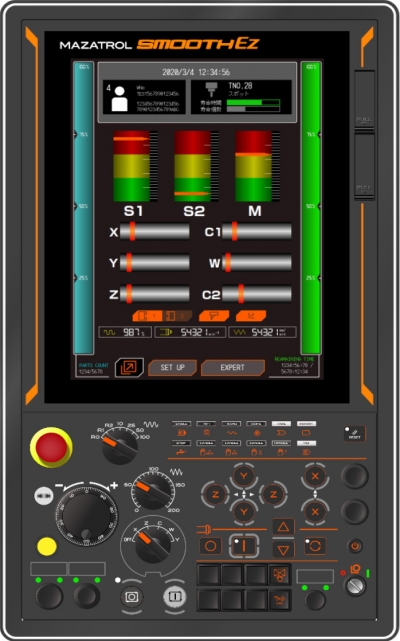
Mazak Corporation has announced the release of its latest machine control, the MAZATROL SmoothEz CNC. Designed as a control that blends both simplicity and advanced functionality into one platform, the new control debuts on Mazak’s new VC-Ez Series of vertical machining centers and QT-Ez Series of turning machines. The new Ez Series, including the new control, was developed specifically to help remove the cost barriers to acquiring the latest manufacturing technology – without sacrificing machine capability or production performance.
The most prominent feature of the MAZATROL SmoothEz CNC is its 15" capacitive touch-screen display, which accommodates a full-width on-screen keyboard or up to 60 lines of code. The NC system operates on two 800 MHz CPUs with an expanded 512 MB of DDR3-SDRAM memory. In addition to its redesigned LAUNCHER screen, the new control also has an expanded range of software features, including SMOOTH Machining Configuration, QUICK MAZATROL, and MAZATROL TWINS that were recently debuted on Mazak’s highly advanced MAZATROL SmoothAi CNC.
Like all Mazak controls, the MAZATROL SmoothEz CNC offers operators access to both EIA/ISO and MAZATROL conversational programming modes. In addition to standard G-codes, the control can use conversationally presented questions to gather the information necessary to automatically generate a part program. Enhanced MAZAROL features, including new end mill pecking cycles for point machining and support for more precise chamfering, further improve the programming mode’s industry- leading usability.
The user interface of the new control has been redesigned for unparalleled ease of use. New button designs and input modes, including the full-width keyboard, can be configured in a variety of ways to produce custom screens that match the layout with the operator’s ergonomic needs. Screen graphics can be enlarged or reduced as needed by the operator. Plus, the wholly redesigned LAUNCHER screen takes
advantage of the full 15" touch screen to simplify navigation with large buttons designed for the shop floor environment which provide one touch navigation to any desired screen on the control.
The MAZATROL SmoothEz CNC also offers expanded functionality with options previously available only on the MAZATROL SmoothAi control. This includes QUICK MAZATROL, which displays a 3D model of a part as it’s being created in real time to help users edit and confirm their programs, as well as full compatibility with MAZATROL TWINS and SMOOTH CAM Ai. Using these tools’ Solid MAZATROL programming, Virtual Machining and Cutting Adviser functions significantly reduce setup time through efficient program creation and simulation.
Further contributing to the new control’s ability to help shops improve program management is its compatibility with SMOOTH Project Manager. This software, which can be operated using commercial PCs in the front office and tablets at the machine, allows shops to easily manage CAD/CAM programs by bundling together programs, parameters, tool data and work offsets. The resulting project data can then be loaded on machines as a single package to reduce the time spent inputting data during machine setup.
Contact Details
Related Glossary Terms
- centers
centers
Cone-shaped pins that support a workpiece by one or two ends during machining. The centers fit into holes drilled in the workpiece ends. Centers that turn with the workpiece are called “live” centers; those that do not are called “dead” centers.
- chamfering
chamfering
Machining a bevel on a workpiece or tool; improves a tool’s entrance into the cut.
- computer numerical control ( CNC)
computer numerical control ( CNC)
Microprocessor-based controller dedicated to a machine tool that permits the creation or modification of parts. Programmed numerical control activates the machine’s servos and spindle drives and controls the various machining operations. See DNC, direct numerical control; NC, numerical control.
- computer-aided manufacturing ( CAM)
computer-aided manufacturing ( CAM)
Use of computers to control machining and manufacturing processes.
- conversational programming
conversational programming
Method for using plain English to produce G-code file without knowing G-code in order to program CNC machines.
- milling machine ( mill)
milling machine ( mill)
Runs endmills and arbor-mounted milling cutters. Features include a head with a spindle that drives the cutters; a column, knee and table that provide motion in the three Cartesian axes; and a base that supports the components and houses the cutting-fluid pump and reservoir. The work is mounted on the table and fed into the rotating cutter or endmill to accomplish the milling steps; vertical milling machines also feed endmills into the work by means of a spindle-mounted quill. Models range from small manual machines to big bed-type and duplex mills. All take one of three basic forms: vertical, horizontal or convertible horizontal/vertical. Vertical machines may be knee-type (the table is mounted on a knee that can be elevated) or bed-type (the table is securely supported and only moves horizontally). In general, horizontal machines are bigger and more powerful, while vertical machines are lighter but more versatile and easier to set up and operate.
- numerical control ( NC)
numerical control ( NC)
Any controlled equipment that allows an operator to program its movement by entering a series of coded numbers and symbols. See CNC, computer numerical control; DNC, direct numerical control.
- turning
turning
Workpiece is held in a chuck, mounted on a face plate or secured between centers and rotated while a cutting tool, normally a single-point tool, is fed into it along its periphery or across its end or face. Takes the form of straight turning (cutting along the periphery of the workpiece); taper turning (creating a taper); step turning (turning different-size diameters on the same work); chamfering (beveling an edge or shoulder); facing (cutting on an end); turning threads (usually external but can be internal); roughing (high-volume metal removal); and finishing (final light cuts). Performed on lathes, turning centers, chucking machines, automatic screw machines and similar machines.







